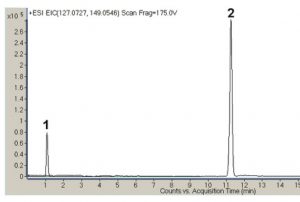Simple Gradient Method with MS Detection
This Method by LCMS detection eliminates derivatization which may be necessary with GCMS Methods. Reversed Phased Methods may run into poor separation of the small and very polar Melamine, resorting to ion pairing reagents to improve separation. The use of these ion pairing reagents counterintuitively results in ionization suppression of the MS source.


Peaks:
1. Cyanuric acid NEG (M-H)- 128.0102 m/z
2. Melamine POS (M+H)+ 127.0727 m/z
Method Conditions
Column: Cogent Diamond Hydride™, 4μm, 100Å
Catalog No.: 70000-15P-2
Dimensions: 2.1 x 150mm
Mobile Phase:
—A: DI Water + 0.1% Acetic Acid
—B: Acetonitrile + 0.1% Acetic Acid
Gradient:
| Time (minutes) | %B |
| 0 | 100 |
| 15 | 50 |
Post Time: 5 minutes
Flow rate: 0.4mL / minute
Detection: Agilent 6210 MSD TOF Mass Spectrometer
t0: 0.8 minutes
Notes: Melamine is not a food product but was found in the past in pet food and also in infant food formulas. It was alleged that Melamine was added intentionally to protein products to gain protein content (testing is for Nitrogen content). Melamine itself has low or no toxicity however Melamine production byproducts often contain Cyanuric Acid, which together with Melamine causes toxicity (by forming insoluble crystals in the kidneys). Due to the adverse effects of Melamine/Cyanuric Acid contamination imported products for infants have to be tested for the presence of these potentially harmful compounds.
Attachment
No 93 Simple Method for Determinations of Cyanuric Acid and Melamine pdf 0.2 Mb Download File


